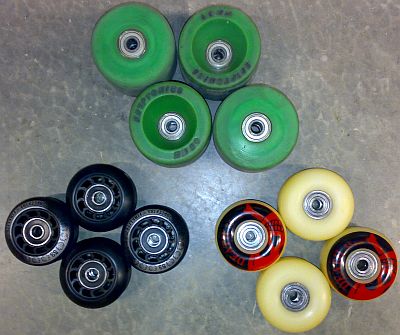The Wheels, usually made of polyurethane, come in many different sizes, shapes and colors to suit different types of skating.
Larger sizes like 65-90 mm roll faster, and also move more easily over cracks in pavement.
Smaller sizes like 48-54 mm keep the board closer to the ground, require less force to accelerate and produce a lower center of gravity, but also make for a slower top speed.
Wheels also are available in a variety of hardnesses. Wheels range from the very soft around 75a to the very hard around 99a, this scale of hardness is measured on the Shore durometer, this scale only goes up to 100a so any company claiming to sell wheels of 101a hardness or higher are ether talking rubbish or not using the correct scale.
Street skaters prefer smaller wheels somewhere around 48-55mm. Street wheels also need to be quite hard, as small soft wheels absorb too much energy.
Vert skating tend to use larger wheels around 55-65mm as vert skating involves high speeds that smaller wheels are unable to sustain. Vert wheels are usually very hard, so they can roll faster. As they are only used on ramps and parks that are smooth they are usually on the harder.
Slalom skating requires even larger wheels around 60-75mm. They need to be soft and be grippy to make the tight turns in slalom racing.
Even larger wheels are used in Longboarding and Downhill skateboarding. Sizes from 65mm to 100mm. These extreme sizes of wheels have cores of hard plastic that can be made thinner and lighter than a solid polyurethane wheel.
--Manufacturers--
